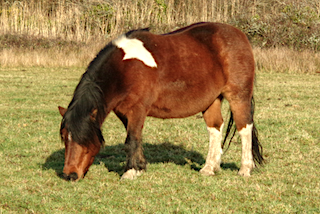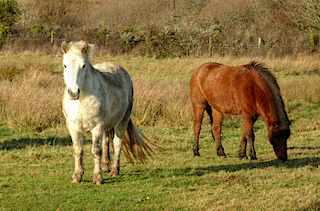 Dartmoor Ponies are a favourite breed for conservation grazing. You can find them on our East Cornwall National Nature Reserves.
Dartmoor Ponies are a favourite breed for conservation grazing. You can find them on our East Cornwall National Nature Reserves.
Photo: Debbie Sea-Kay
Scientific Name: Equus ferus caballus (the scientific name for the domestic horse, of which Dartmoor Ponies are a breed)
Cornish Name: Hoba is the Cornish word for a pony
Status: Granted “endangered” status by the UK Rare Breeds Survival Trust
What to look for:
- Appearance and Colouring: They can be bay, brown, black, grey, roan, or chestnut.
- Size: They should not exceed 12.2 hands in height.
- Where: Free-roaming on Dartmoor, where they are semi-feral managed herds. Also elsewhere, used in conservation grazing and in other functions.
 When you’re out for an invigorating walk on one of our East Cornwall nature reserves, you may well come across some of our ponies, who have an important role to play in preserving biodiversity and supporting East Cornwall’s rare fauna and flora. In this article, though, you can find out a bit more about one of the pony breeds you can see in East Cornwall: the Dartmoor Pony.
When you’re out for an invigorating walk on one of our East Cornwall nature reserves, you may well come across some of our ponies, who have an important role to play in preserving biodiversity and supporting East Cornwall’s rare fauna and flora. In this article, though, you can find out a bit more about one of the pony breeds you can see in East Cornwall: the Dartmoor Pony.
This pony is a small, hardy breed, originating from the moorland and mires of Dartmoor, and bred to cope with the wild upland conditions, supporting farmers and shepherds in their work. They have a broad back and short, strong-boned legs. Their teeth, with a firm, clean bite, are adapted to eating the tough heathland vegetation that other grazers might reject. They are sturdy enough to stay outside throughout the harshness of winter, helped by their thick winter coat: this is two-layered, with a warm under layer of woolly hairs, and a top layer of oily hairs that provide excellent waterproofing. It has a proven ability to maintain itself on poor keep and in exposed conditions, although numerous introductions to the bloodline over recent years have reputedly reduced the breeds’ survival ability.
 The modern type of Dartmoor Pony was established at the end of the nineteenth century.
The modern type of Dartmoor Pony was established at the end of the nineteenth century.
The breed was severely threatened during the Second World War when the army used the moor as a training area, but it was rescued by committed owners. Later, mechanization forced the breed into another decline. In 1988, the Duchy of Cornwall came to the rescue, and established the Moorland Scheme to preserve the Dartmoor Pony in its natural environment. This scheme is now administered by both the Duchy of Cornwall and the Dartmoor Pony Society, with support from Dartmoor National Park. It has been successful and has slowly increased the “true type” of Dartmoor Ponies on the Moor.
Strong and hardy despite its small stature, the Dartmoor Pony is well-suited to the tough conditions you might encounter on the Cornish National Nature Reserves. This makes it a perfect breed for conservation grazing. Its adaptability and resilience, however, means you can find Dartmoors in a variety of roles, from teaching children to ride, to winning competitions as driving ponies.
Did you know…?
…Piebald and skewbald colouring is not permitted within the Dartmoor Pony breed. Ponies with this colouring, seen running on Dartmoor, are likely to be Dartmoor Hill Ponies, as Dartmoor commoners may graze any type of pony out on the moors. The Dartmoor Hill Pony is classified as a pony born on Dartmoor, but not a purebred registered Dartmoor Pony.
… The Dartmoor Pony was used in mediaeval times for carrying heavy loads of tin from the mines across the moor.
… Archaeological investigation in the 1970s has shown that domesticated ponies were found on Dartmoor as early as 1500 BC.
Published: February 2019
Author: Debbie Sea-Kay
Photos: Debbie Sea-Kay
